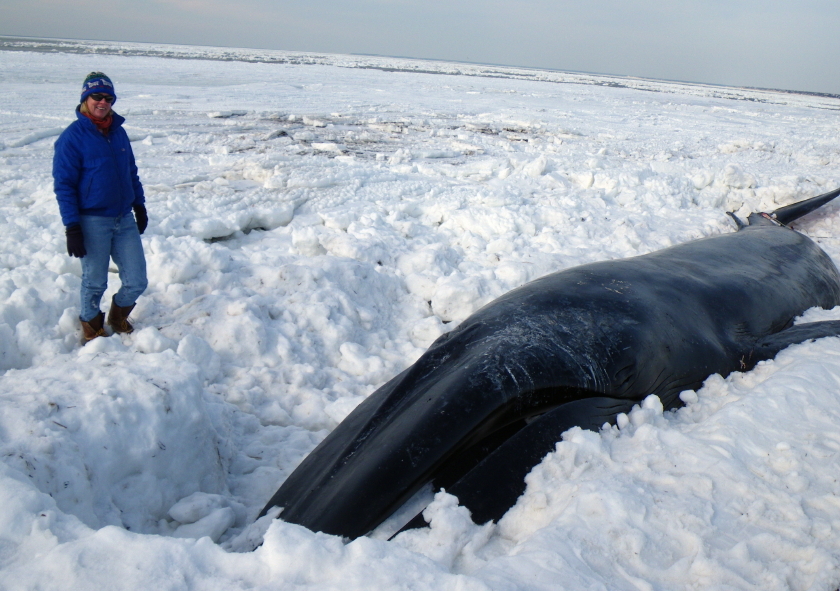(Click here to read original article posted on Wicked Local.)
Wildlife Expert Sue Wieber Nourse Shows Just How Small Two Turtles Can Be (Photo by Ryan Richardson, Wicked Local)
Tiny turtles on hand for talk
By Ryan Richardson
Wed Feb 18, 2009, 06:00 AM EST
WAREHAM – They are hidden everywhere, from the waters of Buzzards Bay to the backyard, a fact many homeowners have found out a little too late while mowing their lawns or backing out of their driveway.
There are almost a dozen species of turtle along the South Coast that visit the waters or make their homes in the areas that are still a little bit wild. From the red-bellied cooter to the loggerhead, the long-living turtles can be found almost everywhere if you know just how to look for them, and few people know where to look better than local turtle experts Don Lewis and Sue Wieber Nourse.
“We’re going to start out with the local guys we run over with our cars…†Lewis interrupted himself. “…That we find in our backyards.â€
On Valentine’s Day, the couple came to the Wareham Free Library to talk about turtles.
The first step was to turn everyone in the room into an expert on the reptiles with one word: temperature.
According to Lewis, temperature was the answer to most questions about how turtles function in the world around them.
Whether they’re terrapins, tortoises or sea turtles, as cold-blooded animals, turtles orient much of their lives around keeping their body temperatures in the right range. They spend their mornings basking in the sun on rock sand logs, and they go into a deep hibernation in the winter when the cold slows their bodies down. Temperature can even determine what sex a turtle will turn out to be after it hatches, since unlike humans, turtles don’t have an X or Y chromosome.
For Lewis and Nourse, teaching about turtles is important because many species are threatened or endangered and serve as a signal that their habitats and the rest of the animals that dwell in them might be in trouble. It also doesn’t hurt that children love turtles, teenage mutant ninja or not, and that connection can be used to teach them about the natural world as a whole.
In Massachusetts, the Eastern box turtle is threatened by the destruction of its habitat due to residential expansion. The turtle typically likes to live at the edge of the woods near grassy fields where it’s easy to find slugs and snails, but their habit of wandering into the grass also leaves them vulnerable to one of their main predators: lawn mowers.
Lewis shared a photo of a box turtle with a shell chipped and marred by mower blades when an inattentive homeowner or grounds keeper has accidentally struck one of these slow moving creatures. Although the turtle’s shell can regenerate, it is neither a safe nor pleasant experience for anyone involved.
The red-bellied cooter is listed as endangered by the Massachusetts Department of Fisheries and Wildlife, its range having been confined to a few pools and ponds within Plymouth County. The turtle is easy to distinguish because the bottom shell is either red (for females) or a pale pink (on males).
The cooter spends its life almost exclusively in the water, coming out to lay its eggs in sandy soil or to migrate if the going gets too tough in their pond. The spread of residential areas and the destruction of Pine Barrens has destroyed much of their local habitat, making it much more difficult for the turtles to migrate.
Herbicides and other chemicals used to treat ponds, pools and bogs also slow down the maturation of the cooter and its reproductive cycle. This means fewer and fewer turtles are laying fewer and fewer eggs. There are certain areas in Plymouth where the turtle has been found that are protected, and while the turtle has been spotted in Wareham, their nesting sites haven’t been located.
“We really nee to know where this turtle is in Wareham,†Lewis said.
Lewis also brought along a few diamondback terrapin hatchlings no bigger than a half-dollar. The terrapin is found from the edge of the Cape to New Bedford, but while it is threatened in Massachusetts for many of the same reasons other turtles are, such as the destruction of its habitat by suburban sprawl, there is another reason in particular: Terrapins were very popular in turtle soup through the middle part of the 1900s.
On his way down to his inauguration, John F. Kennedy was said to have stopped at the home of one socialite for a cup of the soup.
While harvesting the terrapin is now illegal in the commonwealth, the turtle has seen many of the salt-water marshes and estuaries they call home disappear over the years.
Lewis and others are helping the public to see the wildlife around them in the hopes of coexisting a little better, even if it’s just slowing down when turtles are laying their eggs so they don’t run over a few hatchlings during the commute.
Lewis offered one very important reason why turtles were a great animal to study.
“When you get to be a certain age, you like to find a species that you have a chance of catching,†he said.
To find out more about Lewis and Wieber’s investigations into the turtles of the South Coast, visit their Web site at www.turtlejournal.com.













